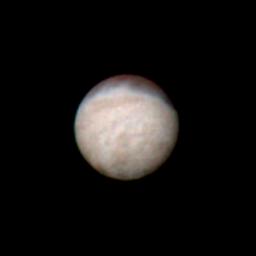
|
Voyager’s Color Image of Triton
- Click the image above for a larger view
- Full-Res JPEG (450 x 450) (6.6 kB)
- Full-Res TIFF (450 x 450) (100.6 kB)
Caption:
Features as small as 100 km (62 miles) across can be seen in this color image of Neptune's satellite Triton, photographed by Voyager 2 on Aug. 20, 1989, while it was still 5.4 million km (3.3 million miles) from Neptune. Triton's overall pinkish color may be due to reddish materials produced by irradiation of methane gas and ice on the satellite. The dark areas near the top of the image seem to be part of a belt of dark markings observed near Triton's equator at different longitudes. Generally, darker areas on Triton appear to be somewhat redder in color than brighter areas. The central longitude in the image is 123 degrees. Here the south pole is at about 6 o'clock, approximately one sixth of the way up from the bottom. The color image was made from three black and white frames, taken through clear, violet and green filters.
Background Info:
The Voyager Mission is conducted by JPL for NASA's Office of Space Science and Applications.
Cataloging Keywords:
| Name | Value | Additional Values |
|---|---|---|
| Target | Triton | Neptune |
| System | Neptune | |
| Target Type | Satellite | Planet |
| Mission | Voyager | |
| Instrument Host | Cassini Orbiter | Voyager 2 |
| Host Type | Orbiter | Flyby Spacecraft |
| Instrument | Imaging Science Subsystem (ISS) | |
| Detector | ||
| Extra Keywords | Color, Methane | |
| Acquisition Date | ||
| Release Date | 2000-02-16 | |
| Date in Caption | 1989-08-20 | |
| Image Credit | NASA/JPL | |
| Source | photojournal.jpl.nasa.gov/catalog/PIA02246 | |
| Identifier | PIA02246 | |
